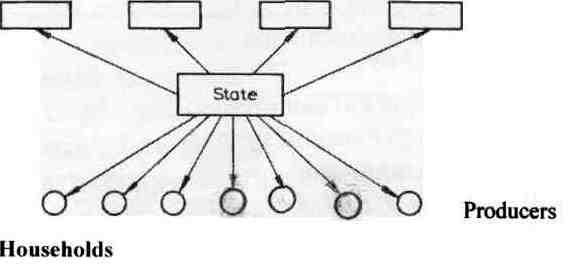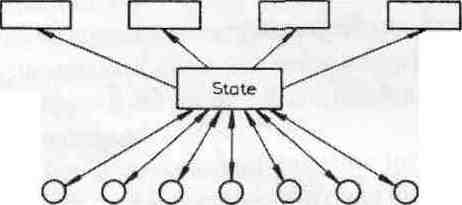
- •Кафедра іноземних мов
- •Донецьк 2009
- •Ббк 65 я 73
- •Contents
- •My speciality. Manager………………………………………….…...19
- •§ 1. Артикль (the article)………………………………….........................170
- •Передмова
- •Introduction
- •Мовленєвий практикум Communication
- •1. The economy of ukraine
- •2. The economy of the usa
- •3. The economy of great britain Lead-in:
- •What is Britain’s economy based on?
- •4. My university
- •5. My speciality. Economist
- •6. My speciality. Manager
- •7. Market
- •8. Company structure
- •9. Forms of business
- •10. Business strategy
- •11. Franchising
- •12. Goods manager
- •13. My speciality. Marketing manager
- •14. My speciality. Customs inspector
- •15. Marketing and promotion
- •16. Types of goods
- •17. Advertising
- •18. Exhibitions and fairs
- •19. My speciality. Accounting and audit
- •20. My speciality. Finance and credit
- •21. My specialty. Banking
- •22. Imf and the world bank
- •23. The banking industry
- •24. Money
- •25. Taxation
- •26. Stock exchange
- •Тексти та вправи Texts and exercises
- •Introducing economics
- •Command economy command economy with some household choice
- •Market economy
- •Fig.1. Simple models of economic system.
- •Summarizing.
- •Viewpoint:
- •The government and market systems
- • Comprehension:
- •Viewpoint:
- •How markets work
- • Comprehension:
- •Viewpoint:
- •Demand and supply
- • Comprehension:
- •Summarizing.
- •Viewpoint:
- •Inflation and deflation
- •Viewpoint:
- •6. Market leaders, challengers and followers
- •Viewpoint:
- •7. Company finance, ownership and management
- •Viewpoint:
- •Summarizing.
- •Viewpoint:
- •Futures, options and swaps
- • Comprehension:
- •Summarizing. Complete the following sentences to summarize the text above:
- •Viewpoint:
- •Buyouts
- •“You can’t buy a company merely by buying its shares”
- •Viewpoint:
- •Principles of taxation
- •Viewpoint:
- •Types of taxes
- •Viewpoint:
- •Foreign direct investment
- •Summarizing:
- •Viewpoint:
- •Accounting and bookkeeping
- •Viewpoint:
- •Accounting and financial nationalments
- •Summarizing:
- •Text organization:
- •Viewpoint:
- •Types of financial satatements
- •Summarizing:
- •Viewpoint:
- •Current account and capital account
- •Complete the following sentences to summarize the text above:
- •Auditing
- •Summarizing:
- •Text organization:
- •Viewpoint:
- •Marketing
- • Comprehension:
- •Summarizing:
- •Viewpoint:
- •The centrality of marketing
- •Is fitting the market to the product.”
- •Viewpoint:
- •Advertizing
- •Summarizing:
- •Text organization:
- •Viewpoint:
- •The business cycle
- • Comprehension:
- •Summarizing:
- •Viewpoint:
- •Macroeconomics
- •Summarizing:
- •Viewpoint:
- •A medium of exchange
- • Comprehension:
- •Summarizing:
- •Viewpoint:
- •Money and banks
- •I had almost said timidity, is the life of banking”
- •Summarizing:
- •Viewpoint:
- •Banking and financial services
- •In great britain
- •Viewpoint:
- •Management
- •Summarizing:
- •Viewpoint:
- •International business
- • Comprehension:
- •Summarizing:
- •Viewpoint:
- •International trade
- •Summarizing: Complete the following sentences to summarize the text above:
- •Viewpoint:
- •Excellent; good; average; poor;
- •31. International trade. Specialization among nations
- •Summarizing:
- •Viewpoint:
- •32. Protectionism and free trade
- • Comprehension:
- •Complete the following sentences to summarize the text above:
- •Viewpoint:
- •33. International oranizations and free trade
- •Viewpoint:
- •Free trade and developing countries
- •Summarizing: Complete the following sentences to summarize the text above:
- •Viewpoint:
- •Economics and ecology
- •Кліше для реферування та анотування Clichés and useful phrases for annotations:
- •For abstracts:
- •Граматичний довідник Grammar reference
- •§ 1. Артикль (the article)
- •§ 2. Іменник (the noun) множина іменників
- •Відмінок (the case)
- •§ 3. Прикметник (the adjective)
- •§ 4. Сполучники as...As, not so...As, than при утворенні ступенів порівняння прикметників
- •§ 5. Числівник (the numeral)
- •Календарні дати
- •§ 6. Займенник (the pronoun)
- •Неозначені займенники
- •§7. Дієслово (the verb)
- •Часи дієслова (tenses)
- •Спосіб дієслова (the mood)
- •Стан дієслова (the voice)
- •Пасивний стан (the passive voice)
- •Особливості вживання речень у пасивному стані в англійській мові
- •Переклад речень з дієсловом у пасивному стані
- •Неозначений час в активному і пасивному стані (The indefinite (Simple) tense, active and passive voice)
- •I am not a student. Я не студент. Вживання
- •Пасивний стан
- •Утворення
- •Вживання
- •Пасивний стан
- •Утворення
- •Вживання
- •Тривалий час в активному
- •Вживання
- •Пасивний стан
- •Утворення
- •Пасивний стан
- •Вживання
- •Перфектний час в активному і пасивному стані (The perfect tense, active and passive voice)
- •Утворення
- •Вживання
- •Пасивний стан
- •Утворення
- •Вживання
- •Пасивний стан
- •Утворення
- •Вживання
- •Вживання
- •§ 8. Дієприкметник
- •(The participle)
- •Дієприкметник теперішнього часу
- •(The present participle)
- •Дієприкметник минулого часу (the past participle) утворення
- •Вживання
- •Функції
- •Перфектний дієприкметник (the perfect participle)
- •Значення та вживання
- •Самостійний дієприкметниковий зворот (the absolute participial construction)
- •§ 9. Інфінітив (the infinitive)
- •Об'єктний інфінітивний комплекс (the objective infinitive complex)
- •Суб'єктний інфінітивний комплекс (the subjective infinitive complex)
- •Прийменниковий інфінітивний комплекс
- •Модальне дієслово can
- •Дієслово may
- •Дієслово must
- •Модальні дієслова should, ought
- •§ 11. Порядок слів в англійському реченні розповідні речення (word order. Affirmative sentences)
- •§ 12. Питальні речення (interrogative sentences)
- •§ 13. Узгодження часів у додатковому підрядному реченні (sequences of tenses)
- •§ 14. Безсполучникові підрядні речення (asyndetic affirmative sentences)
- •§ 15. Умовні речення (conditional sentences)
- •Таблиця неправильних дієслів
- •Граматичні вправи
- •II. Вживання часів Passive Voice
- •Ііі. Модальні дієслова
- •Іv. Інфінітив
- •Вправа 2. Визначте функцію інфінітиву у реченнях. Перекладіть їх на рідну мову.
- •Вправа 3. Вставте "to" де потрібно. Перекладіть речення на рідну мову.
- •Вправа 7. Вставити "to" де потрібно. Перекладіть речення на рідну мову.
- •Вправа 8. Знайдіть Complex Object. Перекладіть речення на рідну мову.
- •Вправа 13. Знайдіть Complex Subject у наступних реченнях. Перекладіть речення на рідну мову.
- •Вправа 16. Перекладіть речення на рідну мову.
- •V. Дієприкметник Вправа 1. Складіть п’ять речень з кожної таблиці.
- •Вправа 4. Знайдіть дієприкметники, встановіть їх форму і функцію. Перекладіть речення на рідну мову.
- •Вправа 8. Замінити наступні складні речення дієприкметниковими конструкціями. Перекладіть речення на рідну мову.
- •Model: The boys who live in this house formed a football team. – The boys living in this house formed a football team.
- •Вправа 17. Перефразуйте наступні речення, використовуючи Absolute Participle Complex. Перекладіть речення на рідну мову.
- •Вправа 18. Знайдіть дієприкметникові комплекси. Перекладіть речення на рідну мову.
- •VI. Ступені порівняння
- •VII. Слова - замінники
- •Vііі. Безсполучникові речення
- •IX. Умовні речення
- •Вправа 8. Утворіть умовні речення. Перекладіть речення на рідну мову.
- •Список використаної літератури references
- •Economics Nowadays
Тексти та вправи Texts and exercises
Introducing economics
|
Lead-in: What do you think economics is concerned with? Key words and phrases: 1. scarce resources – недостатнi ресурси 2. distribution of wealth – розподiл багатства 3. raising revenue – пiдвищування прибутку 4. Gross Domestic Product – валовий внутришний продукт 5. fiscal policy – фiскальна полiтика 6. to allocate resources – розподiляти, розмiщати ресурси 7. output per head – продукція на душу населення
|
Economics is the study of the arrangements that societies make for the use and development of their scarce resources. Economics is concerned with the study of human organisations and communities, the problems of measurement and forecasting.
Nearly all governments are committed to programmes designed to promote the growth of living standards and a more even distribution of wealth both nationally and globally. Can we achieve these objectives without serious conflict between and within the nations?
The ‘economist’ in ancient Greece – a title derived from the words Oikos (house) and Nemo (manage) – was really a ‘steward or eNational manager’. ‘Economica’ (300 b.c.), which might be regarded as an early economics textbook, dealt with raising revenue through various forms of taxation.
There are two ways for the economist to study economics and the economy: macro approach and micro approach. Macroeconomics studies the economy as a whole, it deals with the questions of Gross Domestic Product, aggregate supply and demand, inflation, monetary and fiscal policy, employment and unemployment.
Microeconomics is concerned with the study of individual decision-making units, i.e. an industry, a company, a consumer, the study of how markets work, how prices are determined, how resources are allocated and income is distributed.
All communities are confronted with three fundamental questions concerning the use of their resources:
What to produce?
How to produce?
For whom to produce?
These questions arise because resources are scarce in relation to needs. Although these questions are common to all societies, the methods used for dealing with them will naturally vary enormously – ranging from the primitive subsistence economy to an industrialised one. The way a society answers these fundamental questions is known as its economic system. Economic systems can be classified as traditional (in tribal cultures, for example), command (the former Soviet Union or North Korea), and market systems (the United Nationals, Japan), but no real existing economy is a pure form of above-mentioned ones. Every economy uses a ‘mix’ of allocating mechanisms to answer the basic economic questions. Models shown in Fig.1 attempt to classify these economic systems.

Command economy command economy with some household choice
Producers
H ouseholds
ouseholds
